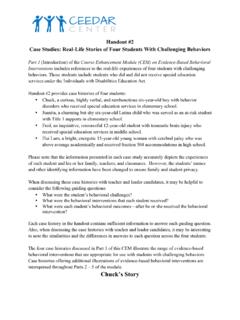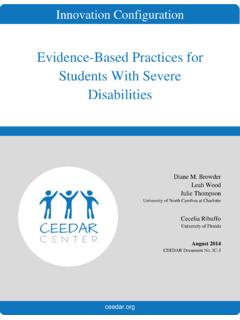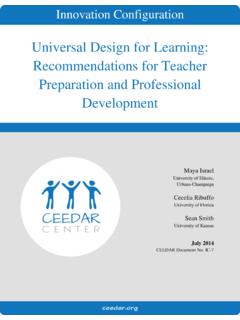Transcription of Evidence-Based Reading Instruction for Adolescents …
1 Innovation Configuration Evidence-Based Reading Instruction for Adolescents Grades 6-12. Martha Hougen University of Florida May 2015. CEEDAR Document No. IC-13. Disclaimer: This content was produced under Department of Education, Office of Special Education Programs, Award No. H325A120003. Bonnie Jones and David Guardino serve as the project officers. The views expressed herein do not necessarily represent the positions or polices of the Department of Education. No official endorsement by the Department of Education of any product, commodity, service, or enterprise mentioned in this website is intended or should be inferred. Recommended Citation: Hougen, M. (2014). Evidence-Based Reading Instruction for Adolescents , grades 6-12. (Document No. IC-13). Retrieved from University of Florida, Collaboration for Effective Educator, Development, Accountability, and Reform Center website: Note: There are no copyright restrictions on this document; however, please use the proper citation.
2 Page 2 of 93. Table of Contents List of Figures .. 6. Innovation Configuration for Evidence-Based Reading Instruction for Adolescents Grades 6-12 .. 7. teacher Education .. 9. Organization of the Innovation Configuration .. 11. Increasing Intensity of Instruction in Tiers 2 and 3 .. 13. Definition of Terms .. 14. adolescent Literacy .. 14. Academic Literacy and Disciplinary Literacy .. 14. Limitations of the Innovation Configuration .. 15. Evidence-Based Reading Instruction : Knowledge of the Essential Components .. 16. Essential Component 1: Word Recognition and Word Study .. 17. Word Recognition .. 17. Word 18. Tier 1: General Education Core Classroom Instruction for All students .. 18. Tiers 2 and 3: Intervention Instruction for Word Recognition and Word 20. Essential Component 2: 22.
3 Evidence-Based Reading Instruction : Fluency .. 24. Tier 1: General Education Core Classroom Instruction for All students .. 24. Tiers 2 and 3: Intervention Instruction .. 25. Page 3 of 93. Essential Component 3: 26. Role of Vocabulary in Comprehension .. 26. Tier 1: General Education 27. Additive, Generative, and Academic Vocabulary Instruction .. 28. Selection of Vocabulary Words to Teach .. 29. Developing Word Consciousness .. 30. Evidence-Based Reading Instruction : Vocabulary .. 31. Tier 1: General Education Core Classroom Instruction for All students .. 31. Tiers 2 and 3: Intervention Instruction .. 35. Essential Component 5: Text Comprehension .. 36. Tier 1: General Education Core Classroom Instruction for All students .. 37. Tiers 2 and 3: Intervention Instruction .. 45. Differentiating Instruction , Instructional and Assistive Technology, Digital and Web- based Instruction , and Universal Design for 46.
4 Differentiating Instruction .. 46. Instructional and Assistive Technology .. 47. Digital and Web- based 48. Universal Design for Learning .. 49. Disciplinary Literacy .. 51. Disciplinary Literacy: English/Language 52. Disciplinary Literacy: Social Studies/History .. 53. Disciplinary Literacy: Science .. 55. Disciplinary Literacy: 55. Page 4 of 93. Tiers 2 and 3: Reading Comprehension Intervention Instruction .. 56. Conclusion .. 58. References .. 59. Appendix: Innovation Configuration for Evidence-Based Reading Instruction for Adolescents , Grades 6-12 .. 94. Page 5 of 93. List of Figures Figure 1: Verbal & Visual Word Association Strategy .. 34. Figure 2: A Word Map .. 35. Page 6 of 93. Innovation Configuration for Evidence-Based Reading Instruction for Adolescents Grades 6-12. This paper features an innovation configuration (IC) matrix that can guide teacher preparation professionals in the development of appropriate use of Evidence-Based Reading Instruction for Adolescents in Grades 6-12.
5 This matrix appears in the Appendix. An IC is a tool that identifies and describes the major components of a practice or innovation. With the implementation of any innovation comes a continuum of configurations of implementation from non-use to the ideal. ICs are organized around two dimensions: essential components and degree of implementation (Hall & Hord, 1987; Roy & Hord, 2004). Essential components of the IC along with descriptors and examples to guide application of the criteria to course work, standards, and classroom practices are listed in the rows of the far left column of the matrix. Several levels of implementation are defined in the top row of the matrix. For example, no mention of the essential component is the lowest level of implementation and would receive a score of zero.
6 Increasing levels of implementation receive progressively higher scores. ICs have been used in the development and implementation of educational innovations for at least 30 years (Hall & Hord, 2001; Hall, Loucks, Rutherford, & Newton, 1975; Hord, Rutherford, Huling-Austin, & Hall, 1987; Roy & Hord, 2004). Experts studying educational change in a national research center originally developed these tools, which are used for professional development (PD) in the Concerns- based Adoption Model (CBAM). The tools have also been used for program evaluation (Hall & Hord, 2001; Roy & Hord, 2004). Use of this tool to evaluate course syllabi can help teacher preparation leaders ensure that they emphasize proactive, preventative approaches instead of exclusive reliance on behavior reduction strategies.
7 The IC included in the Appendix of this paper is designed for teacher preparation programs, although it can be modified as an observation tool for PD purposes. The Collaboration for Effective Educator, Development, Accountability, and Reform (CEEDAR) Center ICs are extensions of the seven ICs originally created by the National Comprehensive Center for teacher Quality (NCCTQ). NCCTQ professionals wrote the above description. Page 7 of 93. Results of recent national and international assessments indicate a combination of good and bad news about adolescent literacy. First, the National Assessment of Educational Progress (NAEP; 2013) Reading results on the May 2014 report indicate that the average Reading scores for fourth- and eighth-graders are higher than on previous test administrations.
8 However, only 36% of eighth-graders and 35% of fourth-graders scored at proficient Reading levels. Second, both Black and Hispanic eighth-graders had higher average Reading scores than on any previous assessment; however, the achievement gaps between Black and Hispanic students and those of White students remain large (NAEP, 2013). Third, high school graduation rates have increased from 74% to 81% for students in freshman classes. However, high school seniors' performance on the national assessment for Reading remained the same when comparing the 2013 results with those from 2009 and have decreased since the test was first administered in 1992. See complete results at The favorable NAEP (2013) news about students with disabilities is that this population is included in the testing, with accommodations as needed.
9 However, the discouraging news is that about 69% of fourth-graders and 60% of eighth-graders with disabilities scored below basic levels in Reading on the 2013 NAEP (see - /student-groups). An analysis of the 2011 vocabulary assessment revealed that, on average, students with disabilities at all three grades ( , fourth grade, eighth grade, and 12th grade). scored lower than students without disabilities ( Department of Education, 2014a). Overall, the Reading scores of secondary students have not significantly improved and have not kept pace with the increasing demands for literacy in the workplace (NAEP, 2011;. RAND, 2002; Department of Education, 2012). Numerous reports published within the past few years have attested to the fact that high school graduates are not prepared for the rigors Page 8 of 93.
10 Of college or the demands of the workplace (Adams, 2011; Hanushek, Peterson, & Woessman, 2014; Kamil et al., 2008; Department of Education, 2014b). There are an estimated six to eight million Adolescents who struggle with Reading in secondary schools (Biancarosa & Snow, 2004; Joftus & Maddox-Dolan, 2003; Vaughn, Denton, & Fletcher, 2010). Some struggling students may have Reading disabilities; however, some of these students are not identified until they are in the upper elementary grades or even secondary school when it is difficult to provide the necessary interventions to close the achievement gap (Hock et al., 2009; Leach, Scarborough, & Rescorla, 2003; Vaughn & Fletcher, 2012). Secondary students with Reading difficulties commonly have difficulties with decoding and fluency, which results in poor Reading comprehension.








